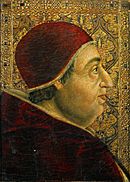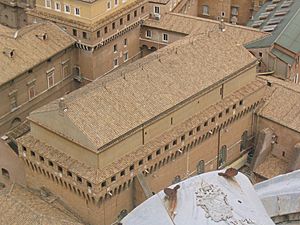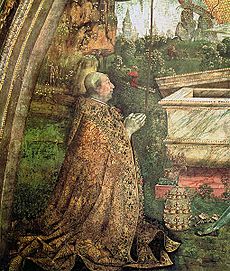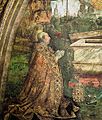1492 papal conclave facts for kids
Quick facts for kids Papal conclaveAugust 1492 |
|
|---|---|
| Dates and location | |
| 6–11 August 1492 Sistine Chapel, Apostolic Palace, Papal States |
|
| Key officials | |
| Dean | Roderic Borja |
| Sub-dean | Oliviero Carafa |
| Camerlengo | Raffaele Riario |
| Protopriest | Luis Juan del Mila y Borja (substituted by Girolamo Basso della Rovere) |
| Protodeacon | Francesco Piccolomini |
| Election | |
| Ballots | 4 |
| Elected pope | |
| Roderic Borja Name taken: Alexander VI |
|
 |
|
A papal conclave is a special meeting where cardinals of the Catholic Church gather to elect a new Pope. The 1492 papal conclave happened from August 6 to August 11, 1492. It took place after Pope Innocent VIII passed away on July 25, 1492. This was the very first conclave to be held inside the famous Sistine Chapel.
During this meeting, Cardinal Roderigo Borja was chosen as the new Pope. He became Pope Alexander VI. People often talk about this election because there were claims that Borja promised gifts and important jobs to cardinals. This was to get their votes. These concerns led to Pope Julius II making stricter rules against this kind of practice in 1503.
Contents
Who Voted: The Cardinal Electors
In 1492, 23 cardinals took part in the conclave. Many of them, 14 to be exact, had been chosen by Pope Sixtus IV. These cardinals, sometimes called "Sistine Cardinals," had a lot of power. They had also chosen the previous Pope, Innocent VIII, in 1484.
Over the years, the group of cardinals had changed a lot. More cardinals were relatives of popes (called cardinal-nephews). There were also more "crown cardinals," who represented powerful kings. Plus, more cardinals came from important Roman families. Most of these cardinals were powerful leaders. They were not always focused on the spiritual side of the Church.
Two cardinals, Gherardo and Sanseverino, were initially not allowed to vote. This was because their appointments had not been publicly announced. However, the College of Cardinals decided to let them join. This happened during the time when the Pope's seat was empty.
Some cardinals thought they might become Pope. They even removed their palace furnishings. This was a safety step. It protected their homes from being looted by the public if they were elected.
Cardinals Who Voted
Here is a list of the cardinals who participated in the 1492 papal conclave:
| Elector | Nationality | Role | When they became Cardinal | Pope who chose them | Notes |
|---|---|---|---|---|---|
| Rodrigo Borja | Kingdom of Valencia | Cardinal-Bishop of Porto e Santa Rufina | February 20, 1456 | Callixtus III | Elected Pope Alexander VI; related to Pope Callixtus III |
| Oliviero Carafa | Neapolitan | Cardinal-Bishop of Sabina | September 18, 1467 | Paul II | Vice Dean of the College of Cardinals |
| Giuliano della Rovere | Savona | Cardinal-Bishop of Ostia and Velletri | December 16, 1471 | Sixtus IV | Dean of the College of Cardinals; related to Pope Sixtus IV; later became Pope Julius II |
| Giovanni Battista Zeno | Venetian | Cardinal-Bishop of Frascati | November 21, 1468 | Paul II | Related to Pope Paul II |
| Giovanni Michiel | Venetian | Cardinal-Bishop of Palestrina | November 21, 1468 | Paul II | Related to Pope Paul II |
| Jorge da Costa | Portuguese | Cardinal-Bishop of Albano | December 16, 1476 | Sixtus IV | Archbishop of Lisbon |
| Girolamo Basso della Rovere | Savona | Cardinal-Priest of S. Crisogono | December 10, 1477 | Sixtus IV | Related to Pope Sixtus IV |
| Domenico della Rovere | Piedmont | Cardinal-Priest of S. Clemente | February 10, 1478 | Sixtus IV | Related to Pope Sixtus IV |
| Paolo di Campofregoso | Genoese | Cardinal-Priest of S. Sisto | May 15, 1480 | Sixtus IV | Former ruler of Genoa |
| Giovanni Conti | Roman | Cardinal-Priest of S. Vitale | November 15, 1483 | Sixtus IV | |
| Giovanni Giacomo Sclafenati | Milanese | Cardinal-Priest of S. Cecilia | November 15, 1483 | Sixtus IV | Bishop of Parma |
| Lorenzo Cibò di Mari | Genoese | Cardinal-Priest of S. Marco | March 9, 1489 | Innocent VIII | Related to Pope Innocent VIII |
| Ardicino della Porta | Milanese | Cardinal-Priest of Ss. Giovanni e Paolo | March 9, 1489 | Innocent VIII | |
| Antoniotto Pallavicini | Genoese | Cardinal-Priest of S. Prassede | March 9, 1489 | Innocent VIII | |
| Maffeo Gherardo, O.S.B.Cam. | Venetian | Cardinal-Priest of Ss. Nereo e Achilleo | March 9, 1489 | Innocent VIII | Patriarch of Venice |
| Francesco Piccolomini | Neapolitan | Cardinal-Deacon of S. Eustachio | March 5, 1460 | Pius II | Later became Pope Pius III; related to Pope Pius II |
| Raffaele Riario | Savona | Cardinal-Deacon of S. Lorenzo in Damaso | December 12, 1477 | Sixtus IV | Related to Pope Sixtus IV |
| Giovanni Battista Savelli | Roman | Cardinal-Deacon of S. Nicola in Carcere Tulliano | May 15, 1480 | Sixtus IV | |
| Giovanni Colonna | Roman | Cardinal-Deacon of S. Maria in Aquiro | May 15, 1480 | Sixtus IV | |
| Giambattista Orsini | Roman | Cardinal-Deacon of S. Maria Nuova | November 15, 1483 | Sixtus IV | |
| Ascanio Sforza | Milanese | Cardinal-Deacon of Ss. Vito e Modesto | March 6, 1484 | Sixtus IV | Member of the powerful Sforza family of Milan |
| Giovanni de' Medici | Florentine | Cardinal-Deacon of S. Maria in Domnica | March 9, 1489 | Innocent VIII | Later became Pope Leo X; member of the ruling family of Florence |
| Federico Sanseverino | Neapolitan | Cardinal-Deacon of S. Teodoro | March 9, 1489 | Innocent VIII |
How the Conclave Worked

A conclave usually starts ten days after a Pope's death. This one was a bit delayed. They waited for an older cardinal, Gherardo, to arrive. He brought a letter from Venice asking for his acceptance. The cardinals had already decided to use the Sistine Chapel for their meetings and voting.
Johann Burchard, a German official, was in charge of the conclave. He kept a detailed diary. He wrote down everything each cardinal received for their stay. This included a table, a chair, and even small items like napkins and sweets.
Before the voting began, there was a special Mass. Then, a speech was given about the challenges facing the Church. Two important positions during this time were given to Spanish officials. This was thought to help Cardinal Borja, who was also Spanish, strengthen his position.
The cardinals also created a set of rules for the new Pope. These rules limited how many new cardinals the new Pope could choose.
The Voting Process
| Country | Number of Electors |
|---|---|
| Papal States, Savona | 4 each |
| Genoa, Milan, Naples, Venice | 3 each |
| Florence, Portugal, Spain | 1 each |
The cardinals voted several times. The first vote happened on August 8. Cardinal Carafa received the most votes, followed by Borja, Costa, and Michiel. Cardinal Giuliano della Rovere also received some votes.
The second vote had similar results. Carafa still led, with Borja close behind.
After three votes, no one had enough support to become Pope. But then, on August 11, Cardinal Rodrigo Borja was elected. Some reports say he received almost all the votes. Others say he received enough to win, and then the other cardinals agreed to make it unanimous.
Claims of Vote-Buying

Many people believed that the election of Alexander VI was not fair. They claimed that votes were bought. This practice is called simony. It means paying for or selling Church positions.
One report from a Venetian ambassador said that the papacy was "sold" through "a thousand villanies." People in Rome even had a saying: "Alexander sells the Keys, the Altar, Christ Himself—he has a right to for he bought them." This showed how widely the rumors spread.
After the third vote, Cardinal Ascanio Sforza realized he would not be elected. It is said that Borja then made him an offer. Sforza allegedly received a very important job, the office of Vice-Chancellor. He also supposedly got a palace, a castle, and a bishopric with a large income. Some sources even claim he received four mule-loads of silver.
Other cardinals also received promises of important positions, towns, or money. For example, Cardinal Orsini was promised fortified towns and a bishopric. Cardinal Colonna was promised an abbey. Even the oldest cardinal, Gherardo, who was 86, reportedly received money. He was said to be the deciding vote.
Some historians also point to financial records. They say that after the conclave, there were unusual debts from the Church to several cardinals. Borja's bank was also said to have had many transactions. This suggests that money might have changed hands.
However, some historians believe that political rivalries were more important than just vote-buying. The strong disagreement between Giuliano della Rovere and Ascanio Sforza might have made Borja a good compromise candidate.
What Happened Next
When Giuliano della Rovere became Pope Julius II in 1503, he took action. He issued a special order called a Papal bull. This bull said that any papal election caused by simony was invalid. It also stated that any cardinal who sold his vote would be removed from his position and excommunicated.
Even though another Pope ruled briefly between Alexander VI and Julius II, the memory of Alexander VI's election was still strong. Julius II himself had faced many challenges from Alexander VI when he was a cardinal. These new rules aimed to prevent such issues in the future.
In Popular Culture
The 1492 papal conclave has been shown in TV shows. It was featured in the 2011 Showtime series The Borgias. Jeremy Irons played Borja in that show. It also appeared in Tom Fontana's Borgia from the same year.
Images for kids
-
The conclave was the first held in the Sistine Chapel
-
Pope Alexander VI, painted by Pinturicchio
See also
 In Spanish: Cónclave de 1492 para niños
In Spanish: Cónclave de 1492 para niños



